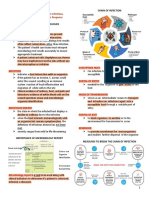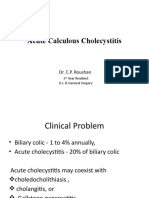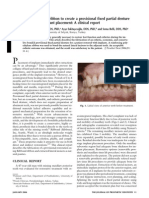100%(1)100% found this document useful (1 vote)
2K viewsHemodialysis NCP
Hemodialysis NCP
Uploaded by
Afia TawiahThe nursing care plan summarizes the risk of infection for a patient undergoing hemodialysis treatment. The plan assesses the patient's vascular access site for signs of infection like redness, swelling or tenderness. Interventions include avoiding contamination of the access site using aseptic technique, monitoring temperature for fever or chills, and administering drugs like heparin or antibiotics to prevent infection or treat it promptly if signs appear. The goal is for the patient to be free of infection during and after the 8-hour nursing intervention period.
Copyright:
© All Rights Reserved
Available Formats
Download as DOCX, PDF, TXT or read online from Scribd
Hemodialysis NCP
Hemodialysis NCP
Uploaded by
Afia Tawiah100%(1)100% found this document useful (1 vote)
2K views2 pagesThe nursing care plan summarizes the risk of infection for a patient undergoing hemodialysis treatment. The plan assesses the patient's vascular access site for signs of infection like redness, swelling or tenderness. Interventions include avoiding contamination of the access site using aseptic technique, monitoring temperature for fever or chills, and administering drugs like heparin or antibiotics to prevent infection or treat it promptly if signs appear. The goal is for the patient to be free of infection during and after the 8-hour nursing intervention period.
Original Title
HEMODIALYSIS NCP.docx
Copyright
© © All Rights Reserved
Available Formats
DOCX, PDF, TXT or read online from Scribd
Share this document
Did you find this document useful?
Is this content inappropriate?
The nursing care plan summarizes the risk of infection for a patient undergoing hemodialysis treatment. The plan assesses the patient's vascular access site for signs of infection like redness, swelling or tenderness. Interventions include avoiding contamination of the access site using aseptic technique, monitoring temperature for fever or chills, and administering drugs like heparin or antibiotics to prevent infection or treat it promptly if signs appear. The goal is for the patient to be free of infection during and after the 8-hour nursing intervention period.
Copyright:
© All Rights Reserved
Available Formats
Download as DOCX, PDF, TXT or read online from Scribd
Download as docx, pdf, or txt
100%(1)100% found this document useful (1 vote)
2K views2 pagesHemodialysis NCP
Hemodialysis NCP
Uploaded by
Afia TawiahThe nursing care plan summarizes the risk of infection for a patient undergoing hemodialysis treatment. The plan assesses the patient's vascular access site for signs of infection like redness, swelling or tenderness. Interventions include avoiding contamination of the access site using aseptic technique, monitoring temperature for fever or chills, and administering drugs like heparin or antibiotics to prevent infection or treat it promptly if signs appear. The goal is for the patient to be free of infection during and after the 8-hour nursing intervention period.
Copyright:
© All Rights Reserved
Available Formats
Download as DOCX, PDF, TXT or read online from Scribd
Download as docx, pdf, or txt
You are on page 1of 2
Tawiah Bernice Ebbi
BSN 4-1
September 10, 2019
NURSING CARE PLAN ABOUT “RISK FOR INFECTION” IN HEMODIALYSIS
Nursing Scientific rationale Planning Intervention Scientific rationale Evaluation
Diagnosis
Risk for Patient who After 8 hours Assessed skin around the Signs of local Goal met
infection undergo dialysis of nursing vascular access, noting infection, which can
treatment have an intervention, redness, swelling, local progress to sepsis if
increased risk for the patient warmth, exudate, untreated
getting healthcare- will be free tenderness.
associated infection from
(HAI). Hemodialysis infection Avoid contamination of Prevents introduction
patients are at high during the access site. Used aseptic of organisms that can
risk for infection therapy. technique and masks when cause infection
because the process giving shunt care, applying
of hemodialysis or changing dressings, and
requires frequent when starting or completing
use of catheters or dialysis process.
insertion of needles
to access the Monitor temperature Note Signs of infection
bloodstream. presence of fever, or sepsis requiring
hemodialysis chills, hypotension. prompt medical
patients have a intervention
weakened immune
system which
increase their risk Administered drug as Infused on arterial
for infection. indicated: Heparin (low-dose side of filter to
prevent clotting in the
filter without systemic
side effects.
Antibiotics (systemic and/or Prompt treatment of
topical) infection may save
access, prevent sepsis
You might also like
- Nursing Care Plan For ThyroidectomyDocument5 pagesNursing Care Plan For ThyroidectomyHARVEY SELIM100% (4)
- Family NCP For HazardDocument3 pagesFamily NCP For HazardAfia TawiahNo ratings yet
- SAUDI Licensing Orthodontics ExaminationDocument34 pagesSAUDI Licensing Orthodontics ExaminationRamy Fathy100% (1)
- Hemodialysis NCPDocument2 pagesHemodialysis NCPAfia Tawiah33% (3)
- 4 Infection ControlDocument45 pages4 Infection ControlJASON KO CHIA SHENGNo ratings yet
- Student Nurses' Community: NURSING CARE PLAN Neonatal SepsisDocument2 pagesStudent Nurses' Community: NURSING CARE PLAN Neonatal SepsisPanJan BalNo ratings yet
- Student Nurses' Community: NURSING CARE PLAN Neonatal SepsisDocument2 pagesStudent Nurses' Community: NURSING CARE PLAN Neonatal SepsisChristian Remetio100% (1)
- Chapter 39 - What Is The Role of Empirical Antibiotic Therapy in SepsisDocument16 pagesChapter 39 - What Is The Role of Empirical Antibiotic Therapy in SepsisIkhlasul Amal WellNo ratings yet
- Finals Micro LecDocument13 pagesFinals Micro Lecvanessa balatucanNo ratings yet
- Hai Final PPTTTDocument34 pagesHai Final PPTTTFanya GomezNo ratings yet
- Febre Na UTIDocument8 pagesFebre Na UTIRafaelNo ratings yet
- Proses Penyakit Infeksi Terkait Yankes Perdalin - Feraibrahim25082022Document52 pagesProses Penyakit Infeksi Terkait Yankes Perdalin - Feraibrahim25082022Inez NeysaNo ratings yet
- Part 3-Surgical Infection (Trans)Document3 pagesPart 3-Surgical Infection (Trans)Robert Francis DikioNo ratings yet
- Safari - 19 Apr 2020 at 18:27Document1 pageSafari - 19 Apr 2020 at 18:27Dream Big PrincessNo ratings yet
- New 1Document23 pagesNew 1api-3701377No ratings yet
- NCP IvDocument3 pagesNCP IvMYKRISTIE JHO MENDEZNo ratings yet
- Ppi KommedDocument13 pagesPpi KommedAhmad Dailah SudrajatNo ratings yet
- Gerberding - 2002 - Academia and Clinic Hospital-Onset Infections A Patient Safety Issue of E VENTSDocument8 pagesGerberding - 2002 - Academia and Clinic Hospital-Onset Infections A Patient Safety Issue of E VENTSEllen Luisa PatolaNo ratings yet
- MicroPara Laboratory - Donning and Doffing of PPEDocument17 pagesMicroPara Laboratory - Donning and Doffing of PPEMeghan Maureen VillacampaNo ratings yet
- 42 - Health Care Associated InfectionDocument59 pages42 - Health Care Associated InfectionSiva100% (1)
- Chapter 12Document35 pagesChapter 12BRENDHIL PACIFICO CRUZNo ratings yet
- Health Care Assosation InfectionsDocument6 pagesHealth Care Assosation Infectionscheskhadomingo33No ratings yet
- NCP Neonatal SepsisDocument3 pagesNCP Neonatal SepsisEzra CabanillaNo ratings yet
- VAP in ICU Summary 30102022Document10 pagesVAP in ICU Summary 30102022rnmero386No ratings yet
- Care Plan Risk For Infection 2Document3 pagesCare Plan Risk For Infection 2Chander KantaNo ratings yet
- M10 FundaDocument6 pagesM10 FundaAl-Khan HadjailNo ratings yet
- Bundles of CareDocument78 pagesBundles of CareAL-NAZAERNo ratings yet
- NCPDocument5 pagesNCPf_jm06_gNo ratings yet
- Nursing Diagnosis Nursing Interventions Rationale: IndependentDocument1 pageNursing Diagnosis Nursing Interventions Rationale: IndependentJessica SurmiedaNo ratings yet
- Hand Hygiene Practices: Travancore Medical College, Kollam. Kerala. IndiaDocument39 pagesHand Hygiene Practices: Travancore Medical College, Kollam. Kerala. IndiaRoery ImoetNo ratings yet
- Antibiotic Prophylaxis in Plastic Surgery: Journal ReadingDocument21 pagesAntibiotic Prophylaxis in Plastic Surgery: Journal ReadingRoby Aditya SuryaNo ratings yet
- Module 7 Apdx CVAntibioticProtocolDocument12 pagesModule 7 Apdx CVAntibioticProtocolKezumath TheForsakenNo ratings yet
- Nosocomial Infections and Infection Control: What's New?Document5 pagesNosocomial Infections and Infection Control: What's New?bouchra8blsNo ratings yet
- Nursing Care of Patients With HIV-AIDSDocument37 pagesNursing Care of Patients With HIV-AIDSKiki Septyanti100% (1)
- Antibiotic SsiDocument6 pagesAntibiotic Ssim8wyb2f6ngNo ratings yet
- CellulitisDocument18 pagesCellulitismuthia saniNo ratings yet
- Hand Hygiene: Panitia Pengendalian Infeksi Nosokomial. Dr. Ahmad D. SudrajatDocument40 pagesHand Hygiene: Panitia Pengendalian Infeksi Nosokomial. Dr. Ahmad D. SudrajatpedsquadNo ratings yet
- Kebersihan Tangan, APD, Peralatan Pasien, Dan Linen 16-2-2023 - CompressedDocument70 pagesKebersihan Tangan, APD, Peralatan Pasien, Dan Linen 16-2-2023 - CompressedSaripa TalaohuNo ratings yet
- Health Care Epidemiology and Infection Prevention and ControlDocument8 pagesHealth Care Epidemiology and Infection Prevention and ControlDiana CalderonNo ratings yet
- Nosocomial Infections in The Neonatal Intensive Care UnitDocument5 pagesNosocomial Infections in The Neonatal Intensive Care Unitnoeldtan.neoNo ratings yet
- Health Care-Associated Infection and Hand Hygiene ImprovementDocument14 pagesHealth Care-Associated Infection and Hand Hygiene ImprovementUyayuLikaNo ratings yet
- Surgical site infection in obstetrics and gynecologyDocument7 pagesSurgical site infection in obstetrics and gynecologyamnahadiarabiaNo ratings yet
- Concepts of Infection ControlDocument53 pagesConcepts of Infection ControlNicoleNo ratings yet
- The Health Professional's Role in Preventing Nosocomial InfectionsDocument5 pagesThe Health Professional's Role in Preventing Nosocomial InfectionsAbdo MohamedNo ratings yet
- NCP Neonatal SepsisDocument1 pageNCP Neonatal SepsisGen-GenMedranoGirayNo ratings yet
- Infected WoundDocument23 pagesInfected WoundMohamed FarahatNo ratings yet
- Medical Surgical Nursing Module 2Document6 pagesMedical Surgical Nursing Module 2JAY TOM BOLIVARNo ratings yet
- Hospital Associated Infections (HAI)Document19 pagesHospital Associated Infections (HAI)Asmaa MostafaNo ratings yet
- Surgical Site Infection 2024Document40 pagesSurgical Site Infection 2024recofa6572No ratings yet
- NCP (Nicu)Document4 pagesNCP (Nicu)teapybomNo ratings yet
- HIV and Anaesthesia Update 25-1-2009Document5 pagesHIV and Anaesthesia Update 25-1-2009Amirul Zakiya BraveryNo ratings yet
- 2018 COMPARATIVE MICRO MeningoencephalitisDocument6 pages2018 COMPARATIVE MICRO MeningoencephalitisMarianneTee-ruhNo ratings yet
- Nursing Care Plan: Assessment Diagnosis Inference Planning Intervention Rationale EvaluationDocument2 pagesNursing Care Plan: Assessment Diagnosis Inference Planning Intervention Rationale EvaluationJamie Haravata0% (1)
- Abses DMDocument19 pagesAbses DMAngel MakinNo ratings yet
- Antibiotics 11 01804 v2Document15 pagesAntibiotics 11 01804 v2pedro villegasNo ratings yet
- Sepsis: Sepsis and Septic ShockDocument22 pagesSepsis: Sepsis and Septic ShockWialda Dwi rodyahNo ratings yet
- Surgical Infections Key Points:: Evolution of Germ Theory and Antisepsis - Aid TheDocument15 pagesSurgical Infections Key Points:: Evolution of Germ Theory and Antisepsis - Aid TheMin dela FuenteNo ratings yet
- NCP & Drug Study (Karisha Guevarra)Document17 pagesNCP & Drug Study (Karisha Guevarra)Karisha GuevarraNo ratings yet
- Nursing Care Plan: Risk For InfectionDocument3 pagesNursing Care Plan: Risk For Infectiongeorgeborja414726100% (3)
- 3 - Acute InfectionsDocument44 pages3 - Acute InfectionsAlexa GabrielaNo ratings yet
- The Ideal Candida Diet Cookbook; The Superb Diet Guide To Alleviate Candida Symptoms And Restore Gut Health With Nutritious RecipesFrom EverandThe Ideal Candida Diet Cookbook; The Superb Diet Guide To Alleviate Candida Symptoms And Restore Gut Health With Nutritious RecipesNo ratings yet
- Erysipeloid Unveiled: Understanding, Diagnosis, and Progressive StrategiesFrom EverandErysipeloid Unveiled: Understanding, Diagnosis, and Progressive StrategiesNo ratings yet
- 1 Spotmap LegendsDocument1 page1 Spotmap LegendsAfia TawiahNo ratings yet
- Fluid Volume Excess NCPDocument3 pagesFluid Volume Excess NCPAfia TawiahNo ratings yet
- Anesthesia DrugsDocument47 pagesAnesthesia DrugsAfia TawiahNo ratings yet
- St. Jude Parish School, Inc. Trece Martires City, Cavite: Certificate of AppearanceDocument6 pagesSt. Jude Parish School, Inc. Trece Martires City, Cavite: Certificate of AppearanceAfia TawiahNo ratings yet
- SambongDocument1 pageSambongAfia TawiahNo ratings yet
- How Cancer Spreads MetastasisDocument6 pagesHow Cancer Spreads MetastasisAfia TawiahNo ratings yet
- DECISION MAKING Presentation in Nursing Leadership and ManagementDocument30 pagesDECISION MAKING Presentation in Nursing Leadership and ManagementAfia Tawiah100% (1)
- First-Aid-Pamphlet Final With CorrectionDocument2 pagesFirst-Aid-Pamphlet Final With CorrectionAfia TawiahNo ratings yet
- A Computer Generated Number: Prepared By: Tawiah Bernice EbbiDocument2 pagesA Computer Generated Number: Prepared By: Tawiah Bernice EbbiAfia Tawiah100% (1)
- Evaluation Tool For IprDocument1 pageEvaluation Tool For IprAfia TawiahNo ratings yet
- NCP FormatDocument2 pagesNCP FormatAfia TawiahNo ratings yet
- Drug Study Blank SheetDocument2 pagesDrug Study Blank SheetAfia TawiahNo ratings yet
- Signs and Symptoms Of: How Does Your Kidneys Do?Document2 pagesSigns and Symptoms Of: How Does Your Kidneys Do?Afia TawiahNo ratings yet
- Medication List SheetDocument2 pagesMedication List SheetAfia TawiahNo ratings yet
- KardexDocument2 pagesKardexAfia TawiahNo ratings yet
- Stroke Heart Attack PamphletDocument5 pagesStroke Heart Attack PamphletAfia TawiahNo ratings yet
- College of Nursing Patient Assignment SheetDocument1 pageCollege of Nursing Patient Assignment SheetAfia TawiahNo ratings yet
- Type of Sampling Description of Methodology Advantages DisadvantagesDocument2 pagesType of Sampling Description of Methodology Advantages DisadvantagesAfia TawiahNo ratings yet
- College of Nursing Nurse'S Notes Date/ Time Focus Data / Action / ResponseDocument1 pageCollege of Nursing Nurse'S Notes Date/ Time Focus Data / Action / ResponseAfia TawiahNo ratings yet
- College of Nursing Plan of ActivitiesDocument2 pagesCollege of Nursing Plan of ActivitiesAfia TawiahNo ratings yet
- Presentation 1Document37 pagesPresentation 1Afia TawiahNo ratings yet
- Khushmeen Kaur11718115Gp3Document1 pageKhushmeen Kaur11718115Gp3OPERATIONAL WINSTARNo ratings yet
- Anesthesia - WikipediaDocument4 pagesAnesthesia - WikipediaTitus GaskinsNo ratings yet
- Hypertrophy Pyloric StenosisDocument7 pagesHypertrophy Pyloric StenosismacmohitNo ratings yet
- Cirrosis BMJDocument91 pagesCirrosis BMJJuan Luis Nuñez Aravena100% (1)
- 2024 CPC Chapter 16 - Anesthesia - StudentDocument8 pages2024 CPC Chapter 16 - Anesthesia - Studentbusinessemail082014No ratings yet
- Animal Tissue by DR. Milan GaihreDocument11 pagesAnimal Tissue by DR. Milan Gaihre5000epcbbNo ratings yet
- Ent - Chronic Suppurative Otitis Media (CSOM)Document22 pagesEnt - Chronic Suppurative Otitis Media (CSOM)Riya SweetsolitudeNo ratings yet
- Vein Visualization Using Near Infrared (NIR) Vein Finder - Pages 213-220Document8 pagesVein Visualization Using Near Infrared (NIR) Vein Finder - Pages 213-220Văn Hiền NguyễnNo ratings yet
- Evaluate and Compare The Use and Effectiveness of PRP (Platelet Rich Plasma) and Threads in Facial RejuvenationDocument11 pagesEvaluate and Compare The Use and Effectiveness of PRP (Platelet Rich Plasma) and Threads in Facial RejuvenationInternational Journal of Innovative Science and Research TechnologyNo ratings yet
- Sports Medicine (Elbow and Spinal Injuries) InjuriesDocument73 pagesSports Medicine (Elbow and Spinal Injuries) InjuriesnhfbyqvgwhNo ratings yet
- Infx 8000 CatlogueDocument18 pagesInfx 8000 Catloguemaheen fatima100% (2)
- Normal Labor and DeliveryDocument142 pagesNormal Labor and DeliveryRosalie RoselloNo ratings yet
- Lecture PharynxDocument28 pagesLecture PharynxHoor AlnabhaniNo ratings yet
- Benign Prostatic Hyperplasia (BPH) : Hyperplasia: Diagnosis and Treatment (1994) Was The Starting Point ForDocument14 pagesBenign Prostatic Hyperplasia (BPH) : Hyperplasia: Diagnosis and Treatment (1994) Was The Starting Point ForAnemiaHemolyticNo ratings yet
- Acute Abdominal Pain RevisiDocument40 pagesAcute Abdominal Pain RevisinadiasalmaNo ratings yet
- Polycystic Liver Disease A Case ReportDocument5 pagesPolycystic Liver Disease A Case ReportEKO SANDY SINAGANo ratings yet
- Accredited Doctors As of Jan. 11Document13 pagesAccredited Doctors As of Jan. 11Miguel Antonio Barretto GarcíaNo ratings yet
- Kaleidoscope Group 2 1Document14 pagesKaleidoscope Group 2 1Bbq c JihyoNo ratings yet
- BPH Nclex QuestionsDocument3 pagesBPH Nclex QuestionspalmasarahhalleyNo ratings yet
- CANINE ManagementDocument17 pagesCANINE ManagementSyed Mohammad Osama AhsanNo ratings yet
- The Failed Hallux ValgusDocument127 pagesThe Failed Hallux ValgusFlorin MacarieNo ratings yet
- Ramesh Chandra Agarwal Vs Regency Hospital LTD SC 2009 Expert Opinion Can Not Be Accepted Without ExaminationDocument18 pagesRamesh Chandra Agarwal Vs Regency Hospital LTD SC 2009 Expert Opinion Can Not Be Accepted Without ExaminationYatn BangadNo ratings yet
- Acute Calculous CholecystitisDocument25 pagesAcute Calculous CholecystitisShankar Lamichhane100% (1)
- The Nasolabial Flap: The Most Versatile Method in Facial ReconstructionDocument7 pagesThe Nasolabial Flap: The Most Versatile Method in Facial Reconstructionshreya dasNo ratings yet
- Colostomy Care & IrrigationDocument18 pagesColostomy Care & Irrigationpbatongbakal100% (2)
- Head and Neck NotesDocument75 pagesHead and Neck NotesHaseeb Ullah ShahNo ratings yet
- Indikasi Torakotomi Chest TraumaDocument6 pagesIndikasi Torakotomi Chest TraumaanglingNo ratings yet
- Use of Polyethylene Ribbon To Create A Provisional Fixed Partial DentureDocument4 pagesUse of Polyethylene Ribbon To Create A Provisional Fixed Partial DentureAhmed AbdulazeezNo ratings yet
- Impaired Skin IntegrityDocument2 pagesImpaired Skin IntegrityBesael BaccolNo ratings yet















































































































